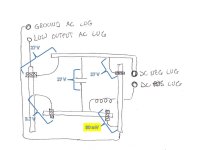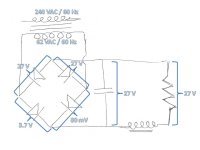CNC Dan
Veteran Member
Yup. You want the voltage drop to be in the arc. Electrode at 25 volts, workpiece at 0 volts. Any additional voltage drop is not wanted.joshuabardwell said:I think I see what you're getting at. But will the loss in power translate to a drop in voltage?
Sort of. In a good welding circuit, most of the 25 volts will be across the arc, and very little in the wireing, diodes, choke, connections.Or would I need something that measures current, like an amp clamp? Current = Volts / Resistance, right? So if resistance goes up somewhere in the circuit, current will drop while voltage will remain constant. No?
In a poor circuit, you might have 25 volts across the arc, and 5 volts accross a bad connection. Or worse two bad connections ( 10 volts).
That will reduce the amount of current flowing in the circuit.
FYI, the current will be the same in any point circuit, at any one moment. Those electrons arn't pileing up anywhere.

